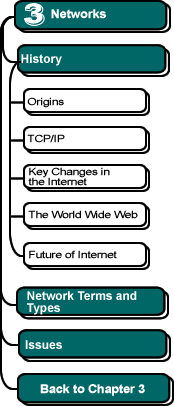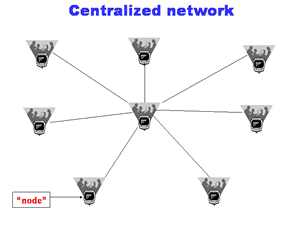

|
A New Kind of Network
One project the IPTO was asked to investigate was the feasibility of a new kind of network.
At the time, the dominant model of a network was that of the nation's only telephone company, AT&T. This network was a centralized network, meaning that all of the nodes (points on the network) communicated through a central switch point.
 This
was a circuit-switching network: in order for one person
to talk to another via telephone, an electrical connection had to be created
between the telephone lines of each person. In old-time movies, this was
done by a human operator who "patched through the call," thereby
creating a temporary, physical electrical circuit over which sounds could
travel. When the call was completed, the circuit was given to two other
callers. Later, this connecting and breaking of circuits was handled by
machines.
This
was a circuit-switching network: in order for one person
to talk to another via telephone, an electrical connection had to be created
between the telephone lines of each person. In old-time movies, this was
done by a human operator who "patched through the call," thereby
creating a temporary, physical electrical circuit over which sounds could
travel. When the call was completed, the circuit was given to two other
callers. Later, this connecting and breaking of circuits was handled by
machines.
 However,
such a system was extremely vulnerable to catastrophe; if the central
switching point failed—e.g., if it were struck by a single Soviet
missile—the entire network would be unable to function. How would
the nation be able to defend itself if it could not communicate?
However,
such a system was extremely vulnerable to catastrophe; if the central
switching point failed—e.g., if it were struck by a single Soviet
missile—the entire network would be unable to function. How would
the nation be able to defend itself if it could not communicate?
The researchers at IPTO concluded that the Cold War called for a new kind of network.
![]()
![]()
This chapter was written by Jeff Nyhoff and Joel Adams. Copy editing by
Nancy Zylstra
©2005 Calvin University (formerly Calvin College), All Rights Reserved
If you encounter technical errors, contact computing@calvin.edu.